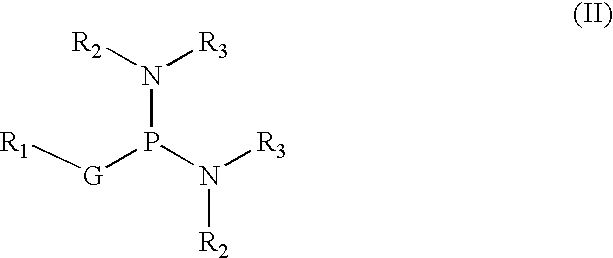Process for manufacturing purified phosphorodiamidite
- Summary
- Abstract
- Description
- Claims
- Application Information
AI Technical Summary
Benefits of technology
Problems solved by technology
Method used
Image
Examples
example 1
2-Cyanoethyl tetraisopropylphosphorodiamidite (Starting with Reagent Contaminated with 0-3% Ethylene
[0258]Hexamethydisilazane (HMDS, 828 g, 5.13 mol) was added to the solution of 3-hydroxypropionitrile (710 g, 10 mol) and toluenesulfonic acid (1.0 g) at 100° C. over 0.5 h. The mixture was stirred at the same temperature for 2 h and distilled under reduced pressure. Bis-trimethylsilyl ethylene glycol is collected first at approximately 65° C. and 20 mmHg (˜60 ml). the product (3-trimethylsilanyloxypropionitrile, or “silyl ether”) was collected at 84–87° C. and 20 mmHg as a colorless liquid (1288.3 g).
[0259]The silyl ether was added to phosphorus trichloride (1624 g, 11.8 mol) with stirring at room temperature over 30 min. The reaction solution was stirred for 12 h at room temperature and evaporated under reduced pressure below 45° C. The residue was co-evaporated with hexanes (2×2 L) under the same conditions to give crude dichlorophosphite (Cl2PO—CH2CH2CN) as a colorless liquid (150...
example 2
2-Cyanoethyl tetraisopropylphosphorodiamidite (Starting with Pure Reagent)
[0261]HMDS (424 g, 2.6 mol) was added to a solution of 3-hydroxypropionitrile (355 g, 5.0 mol) and toluene sulfonic acid (TsOH, 0.5 g) at 60° C. over 0.5 h. The mixture was stirred at the same temperature for 2 h and evaporated at below 60° C. under reduced pressure to give crude 3-trimethylsilanyloxypropionitrile as a cloudy liquid (735 g).
[0262]The crude 3-trimethylsilanyloxypropionitrile was added to phosphorus trichloride (893 g, 6.5 mol) with stirring at room temperature over 30 min. The reaction solution was stirred for 12 h at room temperature and evaporated under reduced pressure below 45° C. The residue was co-evaporated with hexanes (2×1 L) under the same conditions to give crude dichlorophosphite (807 g).
[0263]A mixture of diisopropylamine, hexane and anhydrous potassium carbonate was stirred at −15° C. for 20 min. The crude dichlorophosphite was added at a temperature below −5° C. for 20 min. The r...
example 3
2-Cyanoethyl tetraisopropylphosphorodiamidite
[0264]3-Trimethylsilanyloxypropionitrile (7.56 kg, 52.8 mol) was added to phosphorus trichloride (6 L, (˜9.4 Kg), 68.8 mol) with stirring at room temperature over 30 min. The reaction solution was stirred for 12 h at room temperature and evaporated under reduced pressure below 45° C. The residue was co-evaporated with cyclohexane (2×2 L) under the same conditions to give crude diclorophosphite as a yellow liquid (9.6 kg).
[0265]Diisopropylamine (1 L, 7.12 mol), hexane (1 L) were cooled to 0° C. Phosphorus oxychloride (4.5 ml) was added and the mixture was stirred for 20 min. The crude dichlorophosphite (258 g, 1.5 mol) was added with temperature below 0° C. over 1 hour. The reaction mixture was stirred at room temperature overnight and poured into hexane (1 L). The mixture was washed with water (1 L) and acetonitrile-water (70:30, v / v, 4×500 ml). The hexane layer was evaporated to give the desired product as a colorless liquid (239 g).
PUM
| Property | Measurement | Unit |
|---|---|---|
| Ratio | aaaaa | aaaaa |
| Ratio | aaaaa | aaaaa |
| Dimensionless property | aaaaa | aaaaa |
Abstract
Description
Claims
Application Information
 Login to View More
Login to View More - R&D
- Intellectual Property
- Life Sciences
- Materials
- Tech Scout
- Unparalleled Data Quality
- Higher Quality Content
- 60% Fewer Hallucinations
Browse by: Latest US Patents, China's latest patents, Technical Efficacy Thesaurus, Application Domain, Technology Topic, Popular Technical Reports.
© 2025 PatSnap. All rights reserved.Legal|Privacy policy|Modern Slavery Act Transparency Statement|Sitemap|About US| Contact US: help@patsnap.com



